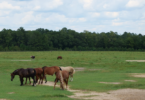ATHENS, Ga. — Periwinkle snails played an important role in saltmarsh die back on barrier islands in Georgia and the Southeast in recent years, according to an article in this month’s issue of the journal Science.
This discovery helps solve the mystery of why an estimated 250,000 acres of marsh grass on the Southeastern coast from Louisiana to Georgia disappeared from 1999 to 2003. Periwinkle snails are found in abundance in most Southeastern salt marsh, but they normally co-exist in healthy balance with the marshes’ dominant plant, cordgrass (Spartina alternaflora). However, according to the study, a severe drought, experienced by the region from 1999 to 2001, weakened plants to the point that grazing snails began to decimate huge tracts of seemingly healthy marsh. This lead to the phenomenon called dead or brown marsh. Citizens and, later, scientists watched with alarm as huge sections of salt marsh began to die off in 1999.
Periwinkle snails are easily spotted in most salt marsh, feeding on the cordgrass just above the water line. They don’t actually consume much of the grass – they are more interested in the fungi that live on the grass. But their chewing damages the grasses’ surfaces, allowing the fungi to further infest the plants. Healthy plants can keep this fungi infestation in check as long as they are not weakened by environmental conditions or required to support too many snails. According to this research, the recent marsh die-off occurred because severe drought stressed the natural defense systems of cordgrass and snails began to kill off the stressed plants. As the plants on which they fed died, the displaced snails began to move toward healthy cordgrass, forming dense fronts. These fronts began to kill off even healthy cordgrass and, in doing so, expanded into a concentrated wave of grazing snails that cascaded through the marsh leaving bare mudflats in its wake.
The paper’s lead author is Brian Silliman, an assistant professor of zoology at the University of Florida. The research was done by a team of scientists from the University of Florida, the Netherlands Institute of Ecology, Louisiana State University and Brown University and was funded by Georgia Sea Grant at the University of Georgia.
The research is significant because the previous model of saltmarsh ecology emphasized the role of “bottom up” factors such as nutrients and the relative level of salt in the marsh as the primary forces in regulating plant growth. Silliman says his research demonstrates the importance of “top down” regulation by the action of the food web. “For ecology in general, the take home lesson here is that increasing climatic extremes, such as drought stress, can trigger the formation of grazer fronts and subsequent waves of habitat die-off in an otherwise stable ecosystem,” Silliman said.







